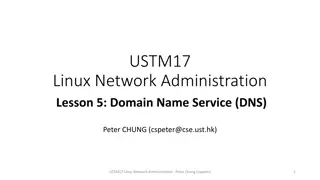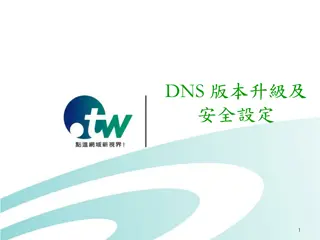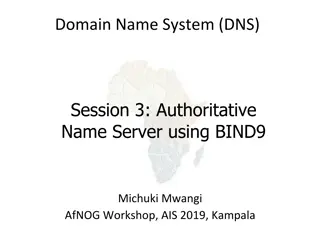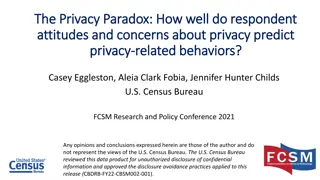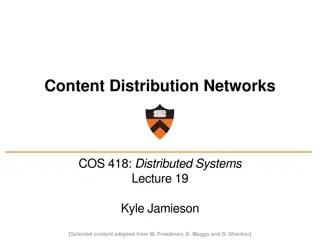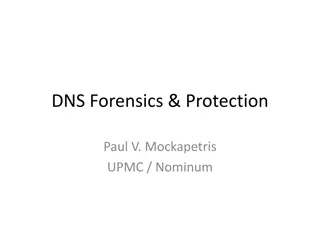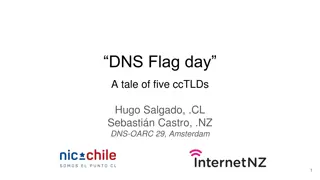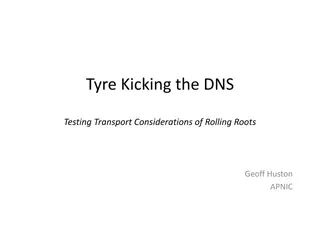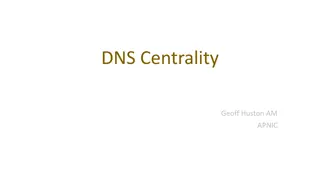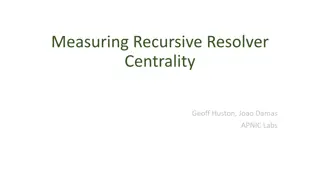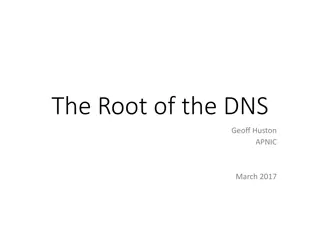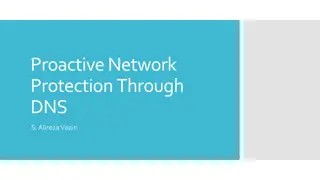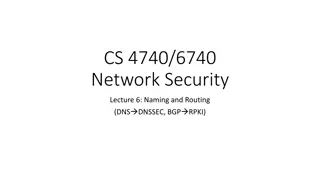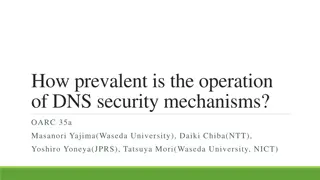Enhancing Privacy in DNS Zone Exchanges
This work presents a privacy-aware schema for efficient distribution of Authoritative DNS Server zones to Recursive DNS Servers or scrubbing services. By utilizing probabilistic data structures like Cuckoo Filters, the system ensures efficient zone mapping, compatibility with existing DNS infrastructure, and support for incremental updates. The approach aims to enhance security and mitigate DDoS attacks effectively in the DNS ecosystem.
Download Presentation

Please find below an Image/Link to download the presentation.
The content on the website is provided AS IS for your information and personal use only. It may not be sold, licensed, or shared on other websites without obtaining consent from the author.If you encounter any issues during the download, it is possible that the publisher has removed the file from their server.
You are allowed to download the files provided on this website for personal or commercial use, subject to the condition that they are used lawfully. All files are the property of their respective owners.
The content on the website is provided AS IS for your information and personal use only. It may not be sold, licensed, or shared on other websites without obtaining consent from the author.
E N D
Presentation Transcript
Enabling Privacy-Aware Zone Exchanges Among Authoritative and Recursive DNS Servers Nikos Kostopoulos, Dimitris Kalogeras and Vasilis Maglaris NETwork Management & Optimal Design (NETMODE) Laboratory School of Electrical & Computer Engineering National Technical University of Athens (NTUA)
Motivation: DNS Water Torture Attacks DDoS attacks can be mitigated more efficiently close to their origins Our use case for DNS: Scrubbing services, Recursive DNS Server Filters However, AXFR requests are typically restricted for security reasons
Contribution (Paper: https://dl.acm.org/doi/abs/10.1145/3404868.3406665) A privacy-aware schema for the efficient distribution of Authoritative DNS Server zones to Recursive DNS Servers or scrubbing services Design Requirements: Privacy-aware zone distribution Efficient zone mapping (storage, filtering latency, consumed bandwidth) Compatibility with the existing DNS infrastructure (AXFR, IXFR requests) Support for incremental updates Relying on probabilistic data structures as datastores for valid Authoritative DNS Server zone names. These fulfill the previous design requirements. Extending previous work: Bloom Filters were used to map the names of large DNS zones and filter suspicious DNS traffic in cloud infrastructures In this work, we implement the zone distribution mechanism Instead of Bloom Filters, we use Cuckoo Filters that support item deletion
Background: Bloom Filters Bitarrays (of m bits) used for Approximate Membership Lookups: Is element x stored in the Bloom Filter? All bits are initially set to 0. Each element is hashed with k different hash functions. Corresponding positions (hash results mod m) are set to 1. m bits 0 0 1 0 0 0 0 1 1 0 0 0 0 0 0 0 0 1 0 0 0 0 1 1 0 0 0 0 0 0 0 0 0 0 1 1 0 0 0 0 0 0 0 0 0 0 0 0 Bits may be shared by multiple items k = 3 word1 word1 word2 False Negatives (Item in the filter, lookup says it is not): Impossible False Positives (Item not in the filter, lookup says it is): Possible
Bloom Filter based Approaches for DNS Related approaches: - Mapping DNSSEC zone names to accelerate authenticated responses - Logging DNS data - Detecting botnet traffic - Tracking newly observed domain names Privacy-aware approaches, but deletions are not supported Cuckoo Filters vs Bloom Filters: Cuckoo Filters are more time and space efficient Cuckoo Filters support element deletion
Background: Cuckoo Filters Elements are inserted as fingerprints in entries of a 2D array - Fingerprints of size f bits are calculated using the function fgp(x) Cuckoo Filters are characterized by: - Number of available buckets m - Fingerprint entries b per bucket Each element x is assigned a pair of buckets 1and 2: Example for m=4, b=2: ?1? = ???? ? ?2? = ?1? ????(??? ? Inserting y fingerprint ?1? Inserting x fingerprint 2 times ?1? ?2? ?2? ??? ? ??? ? ??? ? ??? ? ??? ? One of the two buckets is randomly selected fgp(x) evicted to alternate bucket x and y share a bucket
Baseline Design Privacy-Aware Zone Manager Hashed DNS Zones Incremental DNS Zones
Implementation: The Privacy-Aware Zone Manager Builds and maintains the Cuckoo Filters whose fingerprints are used to create and revise the privacy-aware DNS zones Actions: Retrieves Plaintext DNS Zone RR s, hashes their FQDN into fingerprints, creates Cuckoo Filters and the Hashed DNS Zones Retrieves Plaintext DNS Zone changes regularly, updates the in memory Cuckoo Filters and updates the Incremental DNS Zones Ignores RR s whose value was updated, but their FQDN did not change Special treatment for RR s that share FQDN s with others, but differ in RR type and/or value (usage of frequency counters) - Implemented in Python 3 - Murmurhash3 for fingerprint and hash calculations
Implementation: Hashed DNS Zones (1) These zones hold the FQDN s of the Plaintext DNS Zones hashed and mapped in Cuckoo Filters (Use of AXFR) Serialization format (zone hszn.tld): Cuckoo Filter parameters & algorithms: - Number of buckets m, fingerprint size f, number of entries b - Algorithms used for fingerprint and candidate buckets calculation
Implementation: Hashed DNS Zones (2) Example for the 1stdata RR of the .ntua.gr Hashed DNS Zone Cuckoo Filter with: - 12 bit fingerprints - b=4 entries / bucket Rules: Equally sized fingerprints of ?/4 Bytes (hex digits). Fingerprints requiring less than ?/4 Bytes are prepended with 0 s The fingerprints of multiple Cuckoo Filter buckets are mapped sequentially within a single TXT type RR Buckets with vacant entries require a trailing dot as they do not have explicit boundaries. Full buckets do not. TXT type RR limit: 255 Bytes
Implementation: Incremental DNS Zones They map name changes of Plaintext DNS Zones (Use of IXFR) Serialization format (zone inczn.tld): Rules: last-serial: Changes prior to this value are incorporated in the Hashed DNS Zones. Starting point for Recursive DNS Servers to begin retrieving data from an Incremental DNS Zone sequence: Defines if a Hashed DNS Zone is stale and must be downloaded again, e.g. when Cuckoo Filter parameters change Updates: The fingerprint of the name that changed, action (name added/deleted) and buckets of the fingerprint in the Cuckoo Filter
Evaluation: Testbed & Dataset Testbed: - Authoritative DNS Server: VM with 2 vCPUs, 16 GB RAM - DNS Software: BIND9 Available DNS Zones: - .ntua.gr: 8,294 distinct FQDN s - .su: 109,719 distinct FQDN s - .se: 1,387,690 distinct FQDN s - .ru: 5,325,231 distinct FQDN s
Hashed DNS Zones Privacy-Awareness Cuckoo Filters store names hashed insight into zone contents by performing brute force attacks , but attackers may attempt to gain Target: Assess the capabilities of Cuckoo Filters to withstand brute force attacks in the context of DNS Evaluation of True Positives (TP s) and False Positives (FP s) looking up all permitted name combinations with 1stlabel length of 3-7 chars - Zone: ntua.gr - FP ratio: 0.3% - 37 possible characters (letters, digits, hyphen) - FQDN s with 1stlabel longer than 5 chars protected with high certainty - Longer 1stlabels result into more False Positives
Hashed DNS Zones Serialization Target: Determine the applicability of diverse data serialization formats for mapping zone names into Hashed DNS Zones Considered serialization formats: - Cuckoo Filter with multiple buckets mapped within each RR - Cuckoo Filter with a single bucket mapped within each RR - Bloom Filter with multiple Bytes mapped within each RR andwidth consumption during an AXFR request: The Cuckoo Filter with multiple buckets/RR format outperforms the others
Hashed DNS Zones Management Target: Latency comparison of actions related to managing the Hashed DNS Zones using both Bloom Filters and Cuckoo Filters Actions: - Initial creation of the Hashed DNS Zones in memory - Updating the data structures (1,000 insertions, 1,000 deletions) Bloom Filters are created faster than Cuckoo Filters due to the element eviction process of Cuckoo Filter insertions (single time action) Cuckoo Filters rapidly incorporate changes (Bloom Filters are rebuilt)
Conclusion & Future Work Our approach is promising for distributing Authoritative DNS Server zone names efficiently, while preserving privacy Future Work: Investigate recently proposed probabilistic data structures, e.g. Morton Filters, Xor Filters and Vacuum Filters Employ data plane programming to protect the open channel used for relaying zone exchanges (XDP) Adapt solution to the mitigation of amplification NXNSAttacks Develop a Distributed and Federated Learning detection mechanism that will reduce our zone sizes by excluding infrequently requested names
Enabling Privacy-Aware Zone Exchanges Among Authoritative and Recursive DNS Servers Open-Sourced Code: https://github.com/nkostopoulos/dnspriv Contact Details: nkostopoulos@netmode.ntua.gr Paper from: https://dl.acm.org/doi/abs/10.1145/3404868.3406665 THANK YOU!






